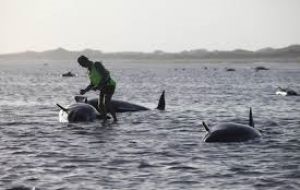MercoPress. South Atlantic News Agency
Desperate struggle in New Zealand to save tens of stranded pilot whales
 The stranding of 198 whales last Friday was one of the largest in recent years and prompted 80 workers and volunteers to help out.
The stranding of 198 whales last Friday was one of the largest in recent years and prompted 80 workers and volunteers to help out.  Even when surviving whales moved to deeper water, experience shows that many of the refloated in the past only return to get stranded again.
Even when surviving whales moved to deeper water, experience shows that many of the refloated in the past only return to get stranded again.  The focus will now turn to the dead whales, and the enormous task of dealing with the carcasses
The focus will now turn to the dead whales, and the enormous task of dealing with the carcasses About 140 pilot whales that stranded themselves on a remote stretch of New Zealand beach have died, but conservation workers and volunteers are hoping the remaining 60 or so will survive after they managed to get them refloated, an official said over the weekend.
The geography of Farewell Spit on the NZ South Island seems to work against whales, which regularly become stranded there. The stranding of 198 whales last Friday was one of the largest in recent years and prompted 80 workers and volunteers to help out.
By late Saturday, 140 of the whales had died, said Department of Conservation area manager Andrew Lamason.He added the workers and volunteers worked throughout the day to keep the surviving whales watered and covered before refloating them during Saturday night's high tide.
“We've had a really good crew of volunteers, and people have been wanting to come from all over the country,” Lamason said.
He said the surviving whales had moved to deeper water. But he cautioned that while hopes for their survival were high, whales had been refloated in the past only to return and get stranded again.
Lamason said the scale of the stranding has been tough on the helpers, both physically and emotionally.
“It's very sad, they're very intelligent animals,” he said. “The pragmatic view is that it's part of nature.”
The focus will now turn to the dead whales, and the enormous task of dealing with the carcasses, Lamason said, adding that while in the past helpers have typically buried them in the sand, he's not sure what the approach will be this time.
He said the department had been experimenting with tethering or moving carcasses into the water, which has the advantage of providing food for other sea creatures.
Experts describe Farewell Spit, located on the northwest corner of the South Island, as a whale trap due to the way its shallow waters seem to confuse whales and diminish their ability to navigate. Pilot whales grow to about 6 meters in length.




Top Comments
Disclaimer & comment rulesCommenting for this story is now closed.
If you have a Facebook account, become a fan and comment on our Facebook Page!